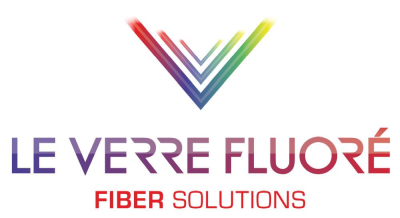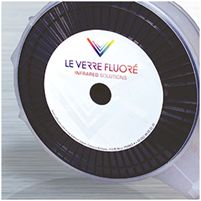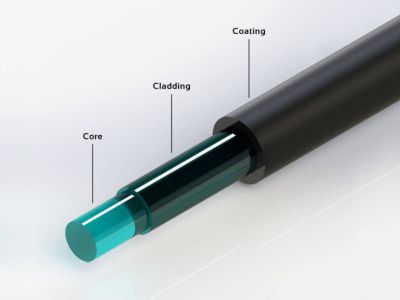fluoride fibers (original) (raw)
Definition: optical fibers based on fluoride glasses
Alternative terms: heavy metal fluoride glass fibers, ZBLAN fibers
Categories:  optical materials,
optical materials,  fiber optics and waveguides
fiber optics and waveguides
- optical fibers
- mid-infrared fibers
* chalcogenide fibers
* germanate fibers
* fluoride fibers
- mid-infrared fibers
Related: fluoride glassesfibersmid-infrared fibersrare-earth-doped fibersfiber amplifiersfiber laserssilica fibersoptical glassesmultiphonon transitionsquenching
Page views in 12 months: 742
DOI: 10.61835/rx3 Cite the article: BibTex BibLaTex plain textHTML Link to this page! LinkedIn
Content quality and neutrality are maintained according to our editorial policy.
📦 For purchasing fluoride fibers, use the RP Photonics Buyer's Guide — an expert-curated directory for finding all relevant suppliers, which also offers advanced purchasing assistance.
Contents
What are Fluoride Fibers?
Fluoride fibers are optical fibers based on fluoride glasses, e.g. fluoroaluminate or fluorozirconate glasses. The cations of such glasses are usually from heavy metals such as zirconium or lead. Fluorozirconate glasses (where ZrF4 is the major component) are a typical example, and among them ZBLAN glass (ZrF4-BaF2-LaF3-AlF3-NaF) is the most common. Such fibers can be doped with a number of rare earth ions for application in fiber lasers and amplifiers. There are also indium fluoride fibers (fluoroindate fibers) with improved infrared transmission at longer wavelengths.
The heavy glass constituents lead to low phonon energies. The most important consequences of this are:
- Fluoride fibers exhibit a reasonably high optical transparency at mid-infrared wavelengths, whereas the common silica fibers absorb light with wavelengths beyond ≈ 2 μm.
- Rare earth dopant ions in fluoride glasses as host media exhibit a strongly reduced tendency for quenching processes caused by multiphonon transitions. Therefore, the lifetimes of various metastable electronic levels can be strongly increased compared with silica fibers, allowing the realization of certain lasers (see below).
Compared with other fibers for mid-infrared transmission, fluoride fibers have a relatively low refractive index and low chromatic dispersion.
A problem with fluoride fibers is that they are relatively difficult to fabricate and thus also expensive. There is a substantial tendency for the formation of crystallites which substantially increase propagation losses by scattering, although in principle very small propagation losses are possible. It has been shown with experiments on the International Space Station that substantially improved fiber properties are possible for fabrication in micro-gravity.
Generally, fluoride fibers are delicate to handle due to their fragility (not allowing, e.g., strong bending) and partly exhibit limited chemical stability, e.g. being hygroscopic. The hygroscopic nature can lead to a limited device lifetime, related to a steady increase of absorption by indiffusion of water / OH; this may be prevented with a suitable fiber coating and with core-less end caps having a diffusion barrier film made of silicon nitride (Si3N4) [24].
Simulations on Fluoride Fibers
Rare earth ions in fluoride fibers can have more metastable states than silica fibers, and thus behave very differently. Their behavior in amplifiers and lasers, for example, can well be simulated with the RP Fiber Power software. This is very flexible, even allowing fully user-defined energy level schemes of laser-active ions.
Applications of Fluoride Fibers
The initially envisaged application of fluoride fibers was optical fiber communications because the intrinsic losses of a mid-IR fiber could in principle be lower than those of silica fibers, which are transparent only up to ≈ 2 μm. However, such low losses as those of silica fibers have not been achieved in practice, and the brittleness and high cost of fluoride fibers also did not support a commercialization in this direction.
Later, the utility of fluoride fibers for various other applications was discovered. The first group of these applications again exploits the mid-infrared transparency of fluoride glasses (→ mid-infrared fibers); examples are mid-infrared laser spectroscopy, fiber-optic sensors, thermometry, and imaging. Also, fluoride fibers can be used to transport light e.g. for Er:YAG lasers at 2.9 μm, as required for medical applications e.g. in ophthalmology and dentistry. In that area, there are also oxide fibers as a possible alternative, in particular germanate glasses, which also contain heavy metals.
On the other hand, the largely suppressed multiphonon transitions in fluoride glasses are very important for the realization of various kinds of fiber lasers and amplifiers, essentially because the upper-state lifetimes of various rare earth dopants become long enough for various laser transitions, particularly in upconversion lasers. For example, thulium-doped fluoride fibers can be used for blue upconversion lasers [7, 14, 15], and erbium-doped fluoride fibers for green upconversion lasers [5]. Praseodymium-doped fluoride fibers can be used in 1.3-μm amplifiers [8] and also for visible fiber lasers with red, orange, green or blue emission [4, 9, 11]. Erbium-doped fluoride glass can be used for realizing 3-μm fiber lasers [18], and also 1.5-μm amplifiers with a wider and flatter gain compared with that of silica-based erbium-doped fiber amplifiers (EDFAs) [17]. It is also possible to combine silica-based and fluoride fibers.
Some fluoride fibers are used for supercontinuum generation in the mid-infrared region, reaching out to wavelengths of several micrometers [23]. Again, the good infrared transmission resulting from the low phonon energy is the key to those achievements, but a suitable location of the zero dispersion wavelength is also important.
Frequently Asked Questions
This FAQ section was generated with AI based on the article content and has been reviewed by the article’s author (RP).
What are fluoride fibers?
Fluoride fibers are optical fibers made from fluoride glasses, such as fluoroaluminate or fluorozirconate glasses. A common example is ZBLAN glass (ZrF4-BaF2-LaF3-AlF3-NaF).
What are the main advantages of fluoride fibers over silica fibers?
Due to their heavy glass constituents, fluoride fibers have low phonon energies. This results in high transparency in the mid-infrared (beyond 2 μm) and strongly reduces non-radiative quenching of rare-earth dopants, enabling certain laser transitions not possible in silica.
What are the main challenges associated with fluoride fibers?
Fluoride fibers are difficult and expensive to fabricate, fragile, and often hygroscopic (sensitive to moisture), which can limit their chemical stability and long-term performance. They also have a tendency to form crystallites, which increases propagation losses.
Why are fluoride fibers used for mid-infrared applications?
Unlike silica fibers, which absorb light beyond ≈2 μm, fluoride fibers are transparent at longer mid-infrared wavelengths. This makes them suitable for laser spectroscopy, fiber-optic sensors, and delivering light from mid-IR lasers like Er:YAG.
How do fluoride fibers benefit upconversion lasers?
The low phonon energy in fluoride glasses suppresses multiphonon transitions, leading to longer upper-state lifetimes for rare-earth ions. This is critical for efficient upconversion lasers, such as thulium-doped blue lasers or erbium-doped green lasers.
What are some applications of rare-earth-doped fluoride fibers?
They are used in fiber lasers and amplifiers. Examples include upconversion lasers for visible light, 3-μm fiber lasers with erbium, and 1.5-μm amplifiers with a broader and flatter gain spectrum than silica-based EDFAs.
Suppliers
Sponsored content: The RP Photonics Buyer's Guide contains four suppliers for fluoride fibers. Among them:
⚙ hardware
LVF offers the largest range of fluoride fibers in the world, including passive fibers and active fibers for applications ranging from the visible to the mid-infrared.
- ZrF4 (fluorozirconate) fibers transmit light from 0.3 µm up to 4.5 µm.
- InF3 (fluoroindate) fibers transmit light from 0.3 µm up to 5.5 µm.
LVF fluoride fibers are the most transparent fibers on the market in the mid-infrared 2–5 µm band.
⚙ hardware
art photonics offers indium and zirconium fluoride glass fibers for transmission of infrared light. There are many single-mode and multimode versions, covering e.g. a wide range of core diameters from 7.5 μm to 680 μm.
Fiber cables with fluoride fibers are also available.
Bibliography
| [1] | D. Tran et al., “Heavy metal fluoride glasses and fibers: A review”, IEEE J. Lightwave Technol. 2 (5), 566 (1984); doi:10.1109/JLT.1984.1073661 |
|---|---|
| [2] | Y. Ohishi, S. Mitachi and S. Takahashi, “Fabrication of fluoride glass single-mode fibers”, J. Lightwave Technol. 2 (5), 593 (1984); doi:10.1109/JLT.1984.1073675 |
| [3] | W. J. Miniscalco et al., “1.3 μm fluoride fiber laser”, Electron. Lett. 24, 28 (1988); doi:10.1049/el:19880019 |
| [4] | R. B. Smart et al., “CW room temperature upconversion lasing at blue, green and red wavelengths in infrared-pumped Pr3+-doped fluoride fibre”, Electron. Lett. 27 (14), 1307 (1991); doi:10.1049/el:19910817 |
| [5] | T. J. Whitley et al., “Upconversion pumped green lasing in erbium doped fluorozirconate fibre”, Electron. Lett. 27 (20), 1785 (1991); doi:10.1049/el:19911110 |
| [6] | J. Y. Allain et al., “Tunable cw lasing around 610, 635, 695, 715, 885 and 910 nm in praseodymium-doped fluorozirconate fibre”, Electron. Lett. 27, 189 (1991); doi:10.1049/el:19910121 |
| [7] | S. G. Grubb et al., “CW room-temperature blue upconversion fibre laser”, Electron. Lett. 28, 1243 (1992); doi:10.1049/el:19920785 |
| [8] | T. Whitley et al., “High output power from an efficient praseodymium-doped fluoride fiber amplifier”, IEEE Photon. Technol. Lett. 5 (4), 401 (1993); doi:10.1109/68.212678 |
| [9] | A. C. Tropper et al., “Analysis of blue and red laser performance of the infrared-pumped praseodymium-doped fluoride fiber laser”, J. Opt. Soc. Am. B 11 (5), 886 (1994); doi:10.1364/JOSAB.11.000886 |
| [10] | Y. Miyajima et al., “Rare-earth-doped fluoride fiber amplifiers and fiber lasers”, Opt. Fiber Technol. 1, 35 (1994); doi:10.1006/ofte.1994.1004 |
| [11] | P. Xie and T. R. Gosnell, “Room-temperature upconversion fiber laser tunable in the red, orange, green, and blue spectral regions”, Opt. Lett. 20 (9), 1014 (1995); doi:10.1364/OL.20.001014 |
| [12] | T. Sakamoto et al., “35-dB gain Tm-doped ZBLYAN fiber amplifier operating at 1.65 μm”, IEEE Photon. Technol. Lett. 8, 349 (1996); doi:10.1109/68.481113 |
| [13] | H. M. Pask et al., “A Pr3+-doped ZBLAN fibre upconversion laser pumped by an Yb3+-doped silica fibre laser”, Opt. Commun. 134 (1–6), 139 (1997); doi:10.1016/S0030-4018(96)00549-4 |
| [14] | R. Paschotta et al., “Characterization and modeling of thulium:ZBLAN blue upconversion fiber lasers”, J. Opt. Soc. Am. B 14 (5), 1213 (1997); doi:10.1364/JOSAB.14.001213 |
| [15] | R. Paschotta et al., “230 mW of blue light from a Tm-doped upconversion fibre laser” (invited paper), IEEE J. S. Top. Quantum Electron. 3 (4), 1100 (1997); doi:10.1109/2944.649548 |
| [16] | M. Poulain, “Fluoride glass fibers: applications and prospects”, Proc. SPIE 3416, 2 (1998); doi:10.1117/12.323374 |
| [17] | J. F. Philipps et al., “Spectroscopic and lasing properties of Er3+:Yb3+-doped fluoride phosphate glasses”, Appl. Phys. B 72, 399 (2001); doi:10.1007/s003400100515 |
| [18] | M. Pollnau and S. D. Jackson, “Erbium 3-μm fiber lasers”, J. Sel. Top. Quantum Electron. 7 (1), 30 (2001); doi:10.1109/2944.924006 |
| [19] | J. F. Philipps et al., “Energy transfer and upconversion in erbium–ytterbium-doped fluoride phosphate glasses”, Appl. Phys. B 74 (3), 233 (2002); doi:10.1007/s003400200804 |
| [20] | E. Heumann et al., “Semiconductor-laser-pumped high-power upconversion laser”, Appl. Phys. Lett. 88, 061108 (2006); doi:10.1063/1.2172293 |
| [21] | H. Ebendorff-Heidepriem et al., “Fluoride glass microstructured optical fiber with large mode area and mid-infrared transmission”, Opt. Lett. 33 (23), 2861 (2008); doi:10.1364/OL.33.002861 |
| [22] | V. Fortin et al., “30 W fluoride glass all-fiber laser at 2.94 μm”, Opt. Lett. 40 (12), 2882 (2015); doi:10.1364/OL.40.002882 |
| [23] | M. Michalska et al., “Mid-infrared, super-flat, supercontinuum generation covering the 2–5 μm spectral band using a fluoroindate fibre pumped with picosecond pulses”, Sci. Rep. 6, 39138 (2016); doi:10.1038/srep39138 |
| [24] | Y. O Aydin et al., “Endcapping of high-power 3 μm fiber lasers”, Opt. Express 27 (15), 20659 (2019); doi:10.1364/OE.27.020659 |
| [25] | H. Uehara et al., “Power scalable 30-W mid-infrared fluoride fiber amplifier”, Opt. Lett. 44 (19), 4777 (2019); doi:10.1364/OL.44.004777 |
| [26] | J. Lan et al., “Toward 10 W-level all-fiber multi-color visible lasers”, Opt. Express 33 (11), 23702 (2025); doi:10.1364/OE.561720 |
(Suggest additional literature!)
Questions and Comments from Users
Here you can submit questions and comments. As far as they get accepted by the author, they will appear above this paragraph together with the author’s answer. The author will decide on acceptance based on certain criteria. Essentially, the issue must be of sufficiently broad interest.
Please do not enter personal data here. (See also our privacy declaration.) If you wish to receive personal feedback or consultancy from the author, please contact him, e.g. via e-mail.
By submitting the information, you give your consent to the potential publication of your inputs on our website according to our rules. (If you later retract your consent, we will delete those inputs.) As your inputs are first reviewed by the author, they may be published with some delay.




